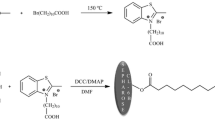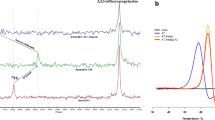Abstract
We report the development of a fast and accurate fluorescence-based assay for amidine linked to cellulose membranes and Sepharose gel. The assay is founded on the glyoxal reaction, which involves reaction of an amidine group with glyoxal and an aromatic aldehyde, leading to the formation of a fluorophore that can be analyzed and quantified by fluorescence spectroscopy and imaging. While the assay has been reported previously for aromatic amidine estimation in solution phase, here we describe its adaptation and application to amidine linked to diverse forms of solid matrices, particularly benzamidine Sepharose and benzamidine-linked cellulose membranes. These functionalized porous matrices find important application in purification of serine proteases. The efficacy of a protein separation device is determined by, among other factors, the ligand (amidine) density. Hence, a sensitive and reproducible method for amidine quantitation in solid phase is needed. The glyoxal reaction was carried out on microbead-sized Sepharose gel and cellulose membranes. Calibration curves were developed for each phase, which established linearity in the range of 0–0.45 μmol per mL amidine for free amidine in solution, 0–0.45 μmol amidine per mL Sepharose gel, and 0–0.48 μmol per mL cellulose membrane. The assay showed high accuracy (~ 3.4% error), precision (RSD < 2%), and reproducibility. Finally, we show how this fluorescent labeling (glyoxal) method can provide a tool for imaging membranes and ligand distribution through confocal laser scanning microscopy.

Graphical abstract





Similar content being viewed by others
References
Yetisen AK, Akram MS, Lowe CR. Paper-based microfluidic point-of-care diagnostic devices. Lab Chip. 2013;13(12):2210–51. https://doi.org/10.1039/C3LC50169H.
Martinez AW, Phillips ST, Butte MJ, Whitesides GM. Patterned paper as a platform for inexpensive, low-volume, portable bioassays. Angew Chem Int Ed. 2007;46(8):1318–20.
Hu J, Wang S, Wang L, Li F, Pingguan-Murphy B, Lu TJ, et al. Advances in paper-based point-of-care diagnostics. Biosens Bioelectron. 2014;54:585–97.
Xu Y, Liu M, Kong N, Liu J. Lab-on-paper micro-and nano-analytical devices: fabrication, modification, detection and emerging applications. Microchim Acta. 2016;183(5):1521–42.
Kim Y, Jang G, Lee TS. New fluorescent metal-ion detection using a paper-based sensor strip containing tethered rhodamine carbon nanodots. ACS Appl Mater Interfaces. 2015;7(28):15649–57. https://doi.org/10.1021/acsami.5b04724.
Li X, Zhao C, Liu X. A paper-based microfluidic biosensor integrating zinc oxide nanowires for electrochemical glucose detection. Microsyst Nanoeng. 2015;1:15014. https://doi.org/10.1038/micronano.2015.14.
Park J, Park J-K. Pressed region integrated 3D paper-based microfluidic device that enables vertical flow multistep assays for the detection of C-reactive protein based on programmed reagent loading. Sensors Actuators B Chem. 2017;246:1049–55. https://doi.org/10.1016/j.snb.2017.02.150.
Yang C, Guan Y, Xing J, Liu H. Development of superparamagnetic functional carriers and application for affinity separation of subtilisin Carlsberg. Polymer. 2006;47(7):2299–304.
Bayramoglu G, Ozalp VC, Altintas B, Arica MY. Preparation and characterization of mixed-mode magnetic adsorbent with p-amino-benzamidine ligand: operated in a magnetically stabilized fluidized bed reactor for purification of trypsin from bovine pancreas. Process Biochem. 2014;49(3):520–8.
Fasoli E, Reyes YR, Guzman OM, Rosado A, Cruz VR, Borges A, et al. Para-aminobenzamidine linked regenerated cellulose membranes for plasminogen activator purification: effect of spacer arm length and ligand density. J Chromatogr B. 2013;930:13–21.
Choi JR, Hu J, Tang R, Gong Y, Feng S, Ren H, et al. An integrated paper-based sample-to-answer biosensor for nucleic acid testing at the point of care. Lab Chip. 2016;16(3):611–21.
Choi JR, Tang R, Wang S, Abas WABW, Pingguan-Murphy B, Xu F. Based sample-to-answer molecular diagnostic platform for point-of-care diagnostics. Biosens Bioelectron. 2015;74:427–39.
Connelly JT, Rolland JP, Whitesides GM. “Paper machine” for molecular diagnostics. Anal Chem. 2015;87(15):7595–601.
Verma MS, Tsaloglou M-N, Sisley T, Christodouleas D, Chen A, Milette J, et al. Sliding-strip microfluidic device enables ELISA on paper. Biosens Bioelectron. 2018;99:77–84.
Lu Y, Shi W, Qin J, Lin B. Fabrication and characterization of paper-based microfluidics prepared in nitrocellulose membrane by wax printing. Anal Chem. 2010;82(1):329–35. https://doi.org/10.1021/ac9020193.
Gong MM, Sinton D. Turning the page: advancing paper-based microfluidics for broad diagnostic application. Chem Rev. 2017;117(12):8447–80. https://doi.org/10.1021/acs.chemrev.7b00024.
Vicente T, Fáber R, Alves PM, Carrondo MJ, Mota JP. Impact of ligand density on the optimization of ion-exchange membrane chromatography for viral vector purification. Biotechnol Bioeng. 2011;108(6):1347–59.
Nestola P, Villain L, Peixoto C, Martins DL, Alves PM, Carrondo MJ, et al. Impact of grafting on the design of new membrane adsorbers for adenovirus purification. J Biotechnol. 2014;181:1–11.
Bhambure R, Gillespie CM, Phillips M, Graalfs H, Lenhoff AM. Ionic strength-dependent changes in tentacular ion exchangers with variable ligand density. I. Structural properties. J Chromatogr A. 2016;1463:90–101.
Bhambure R, Angelo JM, Gillespie CM, Phillips M, Graalfs H, Lenhoff AM. Ionic strength-dependent changes in tentacular ion exchangers with variable ligand density. II. Functional properties. J Chromatogr A. 2017;1506:55–64.
Liesienedot J, Račaitytedot K, Morkevičienedot M, Valančius P, Bumelis B. Immobilized metal affinity chromatography of human growth hormone effect of ligand density. J Chromatogr A. 1997;764(1):27–33.
Belew M, Porath J. Immobilized metal ion affinity chromatography: effect of solute structure, ligand density and salt concentration on the retention of peptides. J Chromatogr A. 1990;516(2):333–54.
Fogle J, Persson J. Effects of resin ligand density on yield and impurity clearance in preparative cation exchange chromatography. II. Process characterization. J Chromatogr A. 2012;1225:70–8.
Lu HL, Lin DQ, Zhu MM, Yao SJ. Effects of ligand density and pore size on the adsorption of bovine IgG with DEAE ion-exchange resins. J Sep Sci. 2012;35(16):2131–7.
Healthcare G (2016) Ligand concentration for Benzamidine Sepharose™ 4 Fast Flow.
Ekeley JB, Ronzio AR. The action of aromatic aldehydes upon the addition products obtained from aromatic amidines and glyoxal. J Am Chem Soc. 1935;57(7):1353–6. https://doi.org/10.1021/ja01310a054.
Fuller A. The estimation of aromatic amidines. Biochem J. 1945;39(1):99.
Fuller AT. A colour reaction for aromatic amidines. Nature. 1944;154:773. https://doi.org/10.1038/154773a0.
Jackson DP, Kuhl WJ, Irvan J. The determination of aromatic amidines in plasma and urine. J Biol Chem. 1947;167:377–86.
Waalkes TP, DeVita VT. The determination of pentamidine (4,4′-diamidinophenoxypentane) in plasma, urine, and tissues. J Lab Clin Med. 1970;75(5):871–8. https://doi.org/10.5555/uri:pii:0022214370900417.
Evans SA, Olson S, Shore J. p-Aminobenzamidine as a fluorescent probe for the active site of serine proteases. J Biol Chem. 1982;257(6):3014–7.
Marroquin M, Bruce T, Pellegrino J, Wickramasinghe SR, Husson SM. Characterization of asymmetry in microporous membranes by cross-sectional confocal laser scanning microscopy. J Membr Sci. 2011;379(1–2):504–15.
Wickramasinghe S, Carlson J, Teske C, Hubbuch J, Ulbricht M. Characterizing solute binding to macroporous ion exchange membrane adsorbers using confocal laser scanning microscopy. J Membr Sci. 2006;281(1–2):609–18.
Schmidt C, Töpfer O, Langhoff A, Oppermann W, Schmidt-Naake G. Depth profiling of graft polymer membranes via confocal laser scanning microscopy. Chem Mater. 2007;19(17):4277–82.
Snyder M, Vlachos D, Nikolakis V. Quantitative analysis of membrane morphology, microstructure, and polycrystallinity via laser scanning confocal microscopy: application to NaX zeolite membranes. J Membr Sci. 2007;290(1–2):1–18.
Wang Y-N, Wei J, She Q, Pacheco F, Tang CY. Microscopic characterization of FO/PRO membranes–a comparative study of CLSM, TEM and SEM. Environ Sci Technol. 2012;46(18):9995–10003.
Wang J, Dismer F, Hubbuch J, Ulbricht M. Detailed analysis of membrane adsorber pore structure and protein binding by advanced microscopy. J Membr Sci. 2008;320(1–2):456–67.
Reichert U, Linden T, Belfort G, Kula M-R, Thömmes J. Visualising protein adsorption to ion-exchange membranes by confocal microscopy. J Membr Sci. 2002;199(1–2):161–6.
Bolte S, Cordelieres F. A guided tour into subcellular colocalization analysis in light microscopy. J Microsc. 2006;224(3):213–32.
Kostinski AB. On the extinction of radiation by a homogeneous but spatially correlated random medium. JOSA A. 2001;18(8):1929–33.
Dmochowski IJ, Dmochowski JE, Oliveri P, Davidson EH, Fraser SE. Quantitative imaging of cis-regulatory reporters in living embryos. Proc Natl Acad Sci U S A. 2002;99(20):12895–900. https://doi.org/10.1073/pnas.202483199.
Gonzalez RC, Woods RE. Digital Image Processing. New Jersey: Prentice Hall; 2002.
Čapek M, Janáček J, Kubínová L. Methods for compensation of the light attenuation with depth of images captured by a confocal microscope. Microsc Res Tech. 2006;69(8):624–35.
Schmid B, Schindelin J, Cardona A, Longair M, Heisenberg M. A high-level 3D visualization API for Java and ImageJ. BMC Bioinf. 2010;11(1):274.
Schindelin J, Arganda-Carreras I, Frise E, Kaynig V, Longair M, Pietzsch T, et al. Fiji: an open-source platform for biological-image analysis. Nat Methods. 2012;9(7):676.
Rueden CT, Schindelin J, Hiner MC, DeZonia BE, Walter AE, Arena ET, et al. ImageJ2: ImageJ for the next generation of scientific image data. BMC Bioinf. 2017;18(1):529.
Funding
This project was supported by the National Science Foundation grant DMR-PREM-1523463. Support was also received from instrumentation facilities created through Institutional Development Award (IDeA) from the National Institute of General Medical Sciences of the National Institutes of Health under grant number P20 GM103475. Additional research infrastructure support and services were provided by the Tropical and Emerging Infectious Diseases Research Program, from the grant U54MD007600 from the National Institute on Minority Health and Health Disparities (NIMHD). Ms. Adriana N Santiago Ruiz received research fellowship from NIH-RISE Program at the University of Puerto Rico in Cayey (grant number 5R25GM059429-20) to participate in this research.
Author information
Authors and Affiliations
Corresponding authors
Ethics declarations
Conflict of interest
The authors declare that they have no conflict of interest.
Research involving human participants and/or animals
Not applicable
Informed consent
Not applicable
Disclaimer
The contents of this manuscript are solely the responsibility of the authors and do not necessarily represent the official view of the NSF or NIH.
Additional information
Publisher’s note
Springer Nature remains neutral with regard to jurisdictional claims in published maps and institutional affiliations.
Electronic supplementary material
ESM 1
(PDF 1664 kb)
Rights and permissions
About this article
Cite this article
Ortiz-Hernandez, C.J., Santiago-Ruiz, A.N., Torres-Rosado, A.J. et al. In situ analysis and imaging of aromatic amidine at varying ligand densities in solid phase. Anal Bioanal Chem 411, 1549–1559 (2019). https://doi.org/10.1007/s00216-019-01588-6
Received:
Revised:
Accepted:
Published:
Issue Date:
DOI: https://doi.org/10.1007/s00216-019-01588-6




